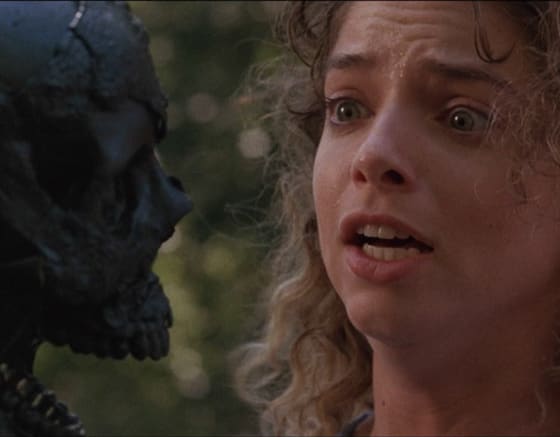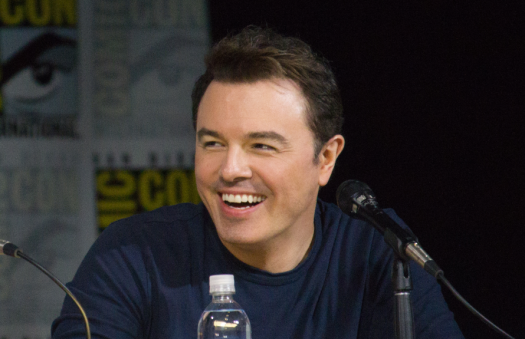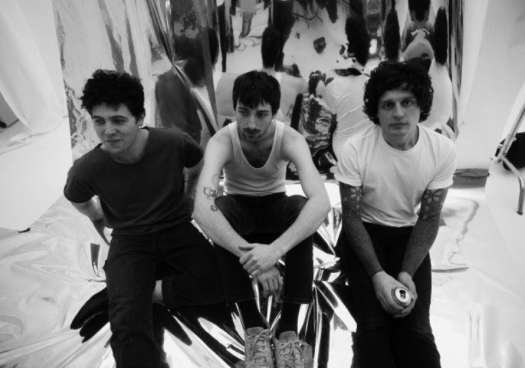At the end of the exhaustive "Making of" documentary included with Shout! Factory's Blu-ray releases of Sleepaway Camp II and Sleepaway Camp III (separately), the cast, crew and director weigh in on which of the two films they preferred. Without fail, each and every person says they preferred the second one. Now, to an outsider, this might seem like comparing vomit to dog shit but, to be fair, there is some logic to this opinion.
The original Sleepaway Camp was a cheap rip-off of the Friday the 13th franchise: an unseen killer murders a bunch of horny camp counsellors shortly after demonstrating moral abject behaviour. But what has given it a lasting presence as a cult film and has made it such a widely analyzed and discussed work within the lexicon of horror theory (beyond the scene of a girl dying from having a curling iron shoved up her bird) was its introduction of a transgender killer. Angela was introduced as a shy girl — the virgin — within the text of the story, only to be later revealed as a vengeful killer with a penis.
In modern terms, this sort of monstrous presentation of a marginalized person — particularly considering the misogynist nature of several of the killings — would be readily attacked. Even at the time, in 1983, some progressives were concerned with the handling of "aberrant" sexuality in this film and what it meant to have a transgender woman — one that was forced into such a position by an unstable external force, no less — portrayed as a moralistic psychopath in mainstream cinema. But more often than not, the gimmick was seen merely as a twist.
That notoriety led to the funding of these sequels, which, based on contract negotiations and limitations, were filmed back-to-back in the same location with many of the same props. Sleepaway Camp II was given more time than part III. The third was filmed primarily during the day in the fall — when it was getting cold — so the production was rushed, the script was written on the fly and the minimal tension generated by night-time spookiness was quashed by an endless array of graphic daytime kills. This also led to the MPAA's rampant slaughter of the movie, demanding that virtually every kill scene be cut from the movie for it to earn an R-rating (the non-stop parade of bare breasts weren't a problem, however).
The other thing that Part II had going for it that Part III didn't (at least in the eyes of its creators) was its increased attention to "plot" and "characters." Now, again, to be fair, the juxtaposition of Angela's (Pamela Springsteen) character with an endless brigade of horny campers was given more time to build and develop in the second film. Angela's tendency to sing camp songs and police the campground makes her an immediate outsider before the storyline pushes her into killing every girl that dares indulge in her own sexuality. The third installation didn't really contextualize or develop anything; Angela poses as a troubled youth to get into an ersatz reform camp where a bunch of one-note ciphers line up for moderately creative kills.
Both films feature the same sort of standardized morality audiences had come to expect from the slasher genre at the time, but what was different was the sense of humour that Pamela Springsteen brought to what were otherwise abysmal movies. In many ways, it's as though Springsteen was aware of just how campy and atrocious these films were, which is why she has such a matter-of-fact approach to delivering her weird sermons on morality and such a curiously amused, almost playful approach to killing people. And since there's nothing terrifying about someone chasing someone around with a big stick in broad daylight, this self-aware depiction did aid in making part III, in particular, more entertaining.
In a way, this sort of defeatist, cartoonish disposition that took over in the third film — when everyone was pretty tired of the production — makes it work better in a modern context. Since the vilification of characters is so lazy — the "racist" girl is introduced by responding to the "virgin's" assertion that a fellow camper is "hot" by scrunching up her nose and saying, "He's Mexican" — that it's often unintentionally hilarious. It's understandable why the director and the crew would favour the movie that was technically "better" made, but as a viewer, the only thing to enjoy here is the badness amidst the astonishingly lethargic direction and incompetent execution.
(Shout! Factory)The original Sleepaway Camp was a cheap rip-off of the Friday the 13th franchise: an unseen killer murders a bunch of horny camp counsellors shortly after demonstrating moral abject behaviour. But what has given it a lasting presence as a cult film and has made it such a widely analyzed and discussed work within the lexicon of horror theory (beyond the scene of a girl dying from having a curling iron shoved up her bird) was its introduction of a transgender killer. Angela was introduced as a shy girl — the virgin — within the text of the story, only to be later revealed as a vengeful killer with a penis.
In modern terms, this sort of monstrous presentation of a marginalized person — particularly considering the misogynist nature of several of the killings — would be readily attacked. Even at the time, in 1983, some progressives were concerned with the handling of "aberrant" sexuality in this film and what it meant to have a transgender woman — one that was forced into such a position by an unstable external force, no less — portrayed as a moralistic psychopath in mainstream cinema. But more often than not, the gimmick was seen merely as a twist.
That notoriety led to the funding of these sequels, which, based on contract negotiations and limitations, were filmed back-to-back in the same location with many of the same props. Sleepaway Camp II was given more time than part III. The third was filmed primarily during the day in the fall — when it was getting cold — so the production was rushed, the script was written on the fly and the minimal tension generated by night-time spookiness was quashed by an endless array of graphic daytime kills. This also led to the MPAA's rampant slaughter of the movie, demanding that virtually every kill scene be cut from the movie for it to earn an R-rating (the non-stop parade of bare breasts weren't a problem, however).
The other thing that Part II had going for it that Part III didn't (at least in the eyes of its creators) was its increased attention to "plot" and "characters." Now, again, to be fair, the juxtaposition of Angela's (Pamela Springsteen) character with an endless brigade of horny campers was given more time to build and develop in the second film. Angela's tendency to sing camp songs and police the campground makes her an immediate outsider before the storyline pushes her into killing every girl that dares indulge in her own sexuality. The third installation didn't really contextualize or develop anything; Angela poses as a troubled youth to get into an ersatz reform camp where a bunch of one-note ciphers line up for moderately creative kills.
Both films feature the same sort of standardized morality audiences had come to expect from the slasher genre at the time, but what was different was the sense of humour that Pamela Springsteen brought to what were otherwise abysmal movies. In many ways, it's as though Springsteen was aware of just how campy and atrocious these films were, which is why she has such a matter-of-fact approach to delivering her weird sermons on morality and such a curiously amused, almost playful approach to killing people. And since there's nothing terrifying about someone chasing someone around with a big stick in broad daylight, this self-aware depiction did aid in making part III, in particular, more entertaining.
In a way, this sort of defeatist, cartoonish disposition that took over in the third film — when everyone was pretty tired of the production — makes it work better in a modern context. Since the vilification of characters is so lazy — the "racist" girl is introduced by responding to the "virgin's" assertion that a fellow camper is "hot" by scrunching up her nose and saying, "He's Mexican" — that it's often unintentionally hilarious. It's understandable why the director and the crew would favour the movie that was technically "better" made, but as a viewer, the only thing to enjoy here is the badness amidst the astonishingly lethargic direction and incompetent execution.




